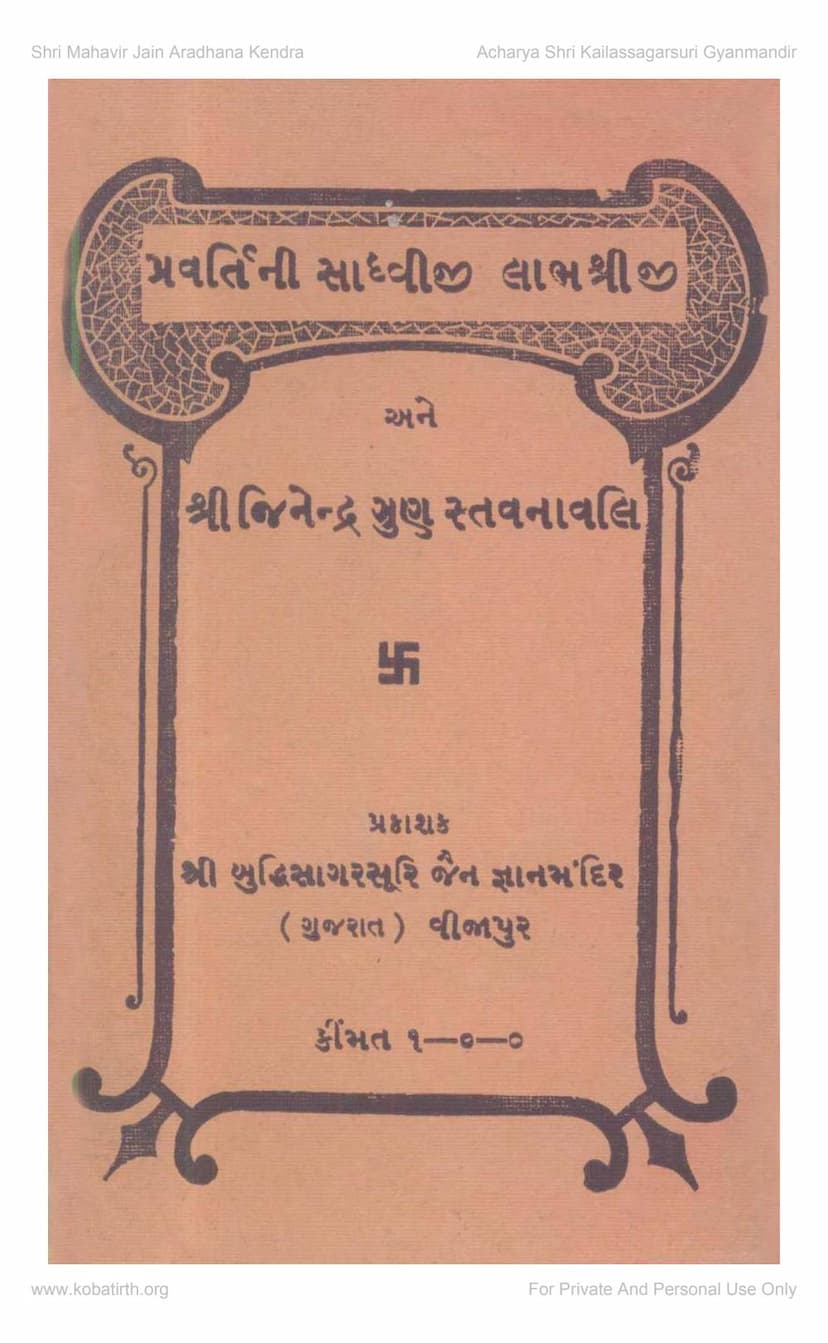Labhashirji Ane Jinendragun Stavanavali
Added to library: September 2, 2025

Summary
This document is a collection of Jain devotional songs (Stavans) and biographical information, primarily focusing on Sadhviji Labhashriji Maharaj and the lineage of Jain monks and nuns.
Here'M a comprehensive summary, broken down by key sections:
I. Introduction and Purpose:
- Title: "Labhashirji ane Jinendragun Stavanavali" (Songs in Praise of Sadhviji Labhashriji and the Virtues of the Jinas).
- Publisher: Buddhisagarsuri Jain Gyanmandir, Vijapur (Gujarat).
- Dedication: The book is dedicated to the memory of Sadhviji Labhashriji Maharaj and the collection of praise songs praising the Tirthankaras (Jinas).
- Underlying Goal: The text aims to celebrate the life and spiritual accomplishments of Sadhviji Labhashriji and to propagate the virtues of Jainism through devotional songs. It emphasizes the importance of a spiritual path and the impact of virtuous individuals within the Jain community.
II. Key Figures and Lineage (Guru Parampara):
- Sadhviji Labhashriji Maharaj: The central figure of the biographical section. The text details her life, spiritual journey, and significant contributions.
- Acharya Shri Buddhisagarsuri: The author of many of the praise songs and a significant figure in the Sagar sect of the Tapagachchha. His teachings and the lineage he represents are highlighted.
- Acharya Shri Ajitsagarsuri: A prominent disciple of Buddhisagarsuri, known for his eloquent discourses and prolific writing in Gujarati and Sanskrit.
- Munishri Hemendrasagar: A highly respected Jain Muni, recognized as "Kaviratna" (Jewel of Poets), who played a crucial role in compiling and inspiring the writing of Sadhviji Labhashriji's biography.
- Sadhviji Vivekshriji: A spiritual successor to Sadhviji Labhashriji, known for her deep penance and dedication to religious work.
- Sadhviji Daulashriji: Another significant spiritual leader in the lineage, noted for her bravery, patience, wisdom, extensive study of scriptures, and dedication to religious propagation. Her life and passing are detailed, highlighting her profound spiritual qualities and impact.
- Sagar Branch/Gachchha: The text emphasizes the peace-loving nature and adherence to principles of the monks and nuns belonging to the Sagar branch, stating their spiritual practice has become exemplary.
- The Chaturvidha Sangha: The document reiterates the Jain principle of the fourfold community (monks, nuns, laymen, and laywomen) and their interconnected importance in the propagation of Dharma.
III. Life of Sadhviji Labhashriji Maharaj:
- Birthplace: Born in Bhumda village, near Pune, in the southern region of India. The area is described as being religiously less developed, hence "Anarya desh" (non-Aryan land) in contrast to the "Arya desh" where Dharma flourishes.
- Family: Born into a respected Dashaporwal family as Lakshmi Bai, to Shah Fatehchand and Ujlibai, who were devout Jains.
- Early Life: Faced significant personal tragedy early in life, including the untimely death of her husband, which deeply impacted her.
- Spiritual Awakening: The loss and the influence of meeting virtuous saints and sadhvis, particularly Sadhviji Devshriji Maharaj, sparked her renunciation and desire for spiritual liberation.
- Diksha (Initiation): Took Bhagavati Diksha at the age of 24 under the guidance of Shri Ravishankar Maharaj, with the full consent of her family. Her name was changed to Labhashriji.
- Spiritual Practice: The text chronicles her extensive travels (Vihar), participation in Chaturmas (monsoon retreat), and her deep dedication to tapas (penance) and Dharma. It mentions her receiving higher initiations and her commitment to studying scriptures.
- Role Model: She is portrayed as a highly influential and virtuous nun, inspiring many to follow the path of Dharma. Her efforts in promoting religious practices among women are highlighted.
- Passing: The document doesn't explicitly detail her final moments but implies a life lived fully in spiritual devotion.
IV. The Praise Songs (Stavanavali):
- The latter part of the document comprises numerous praise songs dedicated to various Tirthankaras and significant Jain concepts. These songs are attributed to different revered spiritual figures, including:
- Shri Buddhisagarsuri: Composed stanzas praising Rishabhdev, Shantnath, Neminath, Parshvanath, Mahavir, Navapad, Vardhaman, and others. His compositions often focus on the philosophical and experiential aspects of Jainism.
- Acharya Shri Ajitsagarsuri: Contributed stanzas praising Vasupujya, Arhat, Chintamani Parshvanath, and others, with a focus on the abstract nature of the divine and the importance of devotion.
- Munishri Hemendrasagar: Author of many stanzas, often reflecting on the teachings of various Tirthankaras and the importance of spiritual guidance. His works seem to be deeply personal and devotional.
- Themes in the Stavanavali:
- Praise of Tirthankaras: Extensive praise for various Tirthankaras like Rishabhdev, Shantnath, Neminath, Parshvanath, Mahavir, Padmanath, Sumatinath, Kunthu, Chandraprabh, Vasupujya, and others.
- Philosophical Concepts: Exploration of key Jain doctrines like soul (Atma), karma, liberation (Moksha), non-violence (Ahimsa), renunciation (Tyaga), meditation (Dhyana), and the significance of the Navapad (nine supreme entities).
- Devotional Love: A strong theme of deep devotion and surrender to the Tirthankaras.
- Pilgrimage Sites: Mentions of important pilgrimage sites like Shatrunjay (Palitana), Girnar, Taranga, Kesariyaji, Bhiladiya, Gwalior, and others.
- Importance of Gurus: Numerous songs highlight the crucial role of a Guru in spiritual progress.
- Ethical and Moral Teachings: Songs often convey moral lessons about detachment, equanimity, and the transient nature of worldly pleasures.
V. Other Biographies/Mentions:
- Dharmavir Shah Maneklal Jaychand: A brief mention of his family lineage and their patronage of Jainism in Manasa.
- Shri Chanchalbhai: Maneklal Sheth's wife, who after his passing, dedicated significant wealth to charitable activities and religious causes.
- Various Sadhvis: The text mentions other significant Sadhvis in the lineage like Devshriji, Harakshriji, Vivekshriji, etc., highlighting their contributions and spiritual lives.
VI. Overall Tone and Message:
The document is devotional, reverent, and informative. It aims to inspire readers by showcasing the exemplary lives of Jain spiritual leaders and by providing devotional content for practice. It underscores the principles of Jainism, emphasizing devotion, penance, detachment, and the pursuit of spiritual liberation. The detailed biographical accounts and the extensive collection of praise songs make it a valuable resource for understanding the spiritual heritage and devotional practices within a specific Jain tradition (Sagar branch of Tapagachchha).